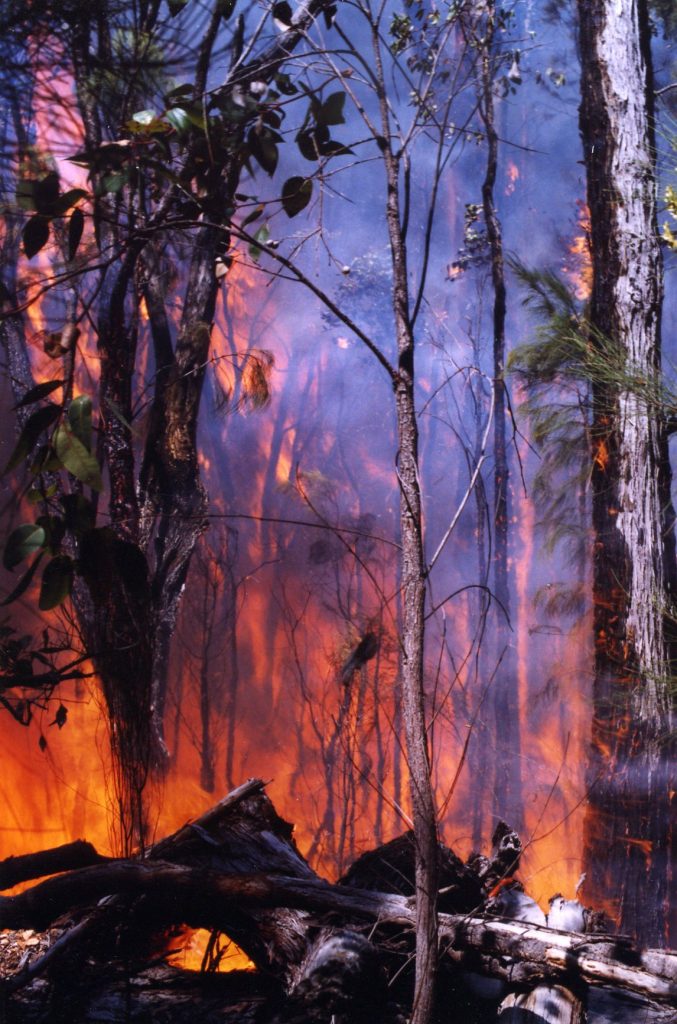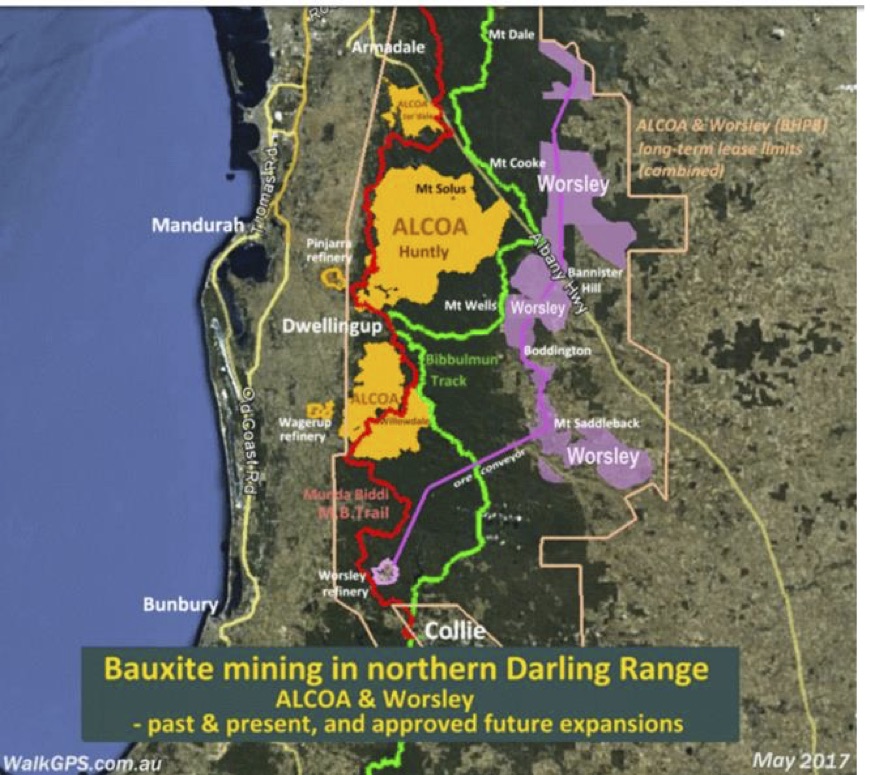It is not generally appreciated what a large proportion of the Western Australian jarrah (Eucalyptus marginata)forest is covered by mining leases for the extraction of bauxite, nor how bauxite mining has greatly complicated forest fire management and hugely increased fuel loads in State forest.
While the bauxite mining and alumina production has undoubtedly been beneficial to the State economically, it has destroyed large areas of native forest, reduced runoff in catchments and left us with long term problems with ongoing forest management. While this industry also has very adverse effects on catchment values, our focus here is on the adverse effects on fire management.
Figure 1.The extent of bauxite mining (current and approved) in the northern jarrah forest (plan courtesy of wwwwalkgps.com.au).
Mining commenced near Jarrahdale in 1965 and later extended south to Huntly and Willowdale. Fast forward 53 years and we now have four large refineries and an annual clearing rate of 800 ha. The industry has clearly been a very profitable one for the companies concerned (Alcoa and Worsley S32)
More than 29,000 ha of jarrah forest have been cleared and 21,000 ha “revegetated”. More recently, direct export of bauxite was approved and has commenced. With no value-adding refining into alumina, direct export of bauxite provides very little benefit to Western Australia.
The mining process occurs on scattered areas of higher quality bauxite and the actual area being worked at any one time varies according to the ore grade requirements.
Figure 2. The patchwork of forest and mine pit due to bauxite mining.
Mining involves the complete removal of the original jarrah forest, then carving off the topsoil which is stockpiled to one side, then the bauxite layer, 3-5 metres in depth is removed, the topsoil is replaced, fertiliser is added and the former mine pit is seeded with a mixture of native eucalypt and understorey species.
Dense regeneration is usually achieved and the rehabilitated areas cannot be prescribed burnt for at least 15 years which means that the fuel loads in the adjacent, unmined forest also increase. As a result, very large sections of forest have dangerously high fuel loads, predisposed to a wildfire event.
Within and around a mining envelope such as that shown on Figure 2, access by Department of Parks and Wildlife for any management operation, such as prescribed burning) is constrained for safety reasons (ore-bearing trucks, blasting activities).
It is expected that the total area of jarrah forest directly impacted by bauxite mining will exceed 80,000 ha. However, as only about 25 percent of the landscape that comprises the mining envelope is mined, the overall impact is much greater (120,000 ha currently and over 300,000 ha in 50 years’ time). Most of the forest between Collie and Armadale is expected to be fragmented by bauxite mining by the year 2060 (see Figs 1 and 2).
The long term effect of bauxite mining will therefore leave the State with a very difficult and costly forest to manage. Fuel reduction burns, which are essential to protect the remainder of the forest as well as nearby townships ands recreation areas, will necessarily be expensive small burns. This should require resourcing by the mining company in perpetuity.
Figure 3. Typical northern jarrah forest – easy to carry out prescribed burns, especially broadscale aerial burns.
The problem in the immediate future is how to burn revegetated mine pits and how to integrate fire management in areas that have been mined into the management of the surrounding forest. Burning can be too hot in some places and too cool elsewhere due to the variable nature of the fuels.
Figure 4. A rehabilitated mine pit – very difficult and expensive to burn safely.
Some older pits also were not regenerated with local species, but with a variety of Eastern States tree species. In part this phase occurred due to concerns at the time over the impact of dieback disease on the pits. The exotic species were used as they were resistant to the disease. As some are not as resistant to fire as jarrah, this is a further complication for fuel reduction burning.
What is needed here is a long term plan to institute effective ways of managing the mining envelopes to minimise fire hazards and eventually integrate fire management on rehabilitated areas with the surrounding forest. This should be a prime objective of the Forest Management Plan, for which the Conservation and Parks Commission is responsible.
One thing that can be done now to reduce fire hazards is to heavily thin the rehabilitated mine pits using a mechanical harvesting technique and controlling the stumps with herbicide ( see our post Protecting Towns From Bushfires). This would, however, require a change in Government policy to allow export of the woody residue so produced, as there are likely to be insufficient local markets for the residue. Pits so treated would be much easier and safer to burn when required, as the thinning operation would flatten the understory and reduce the way they flare in a burn.




